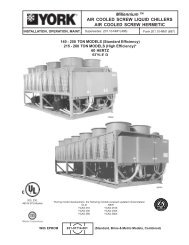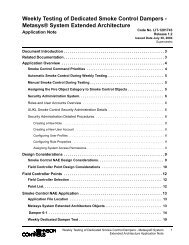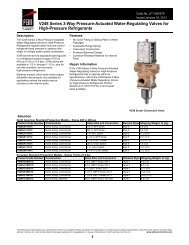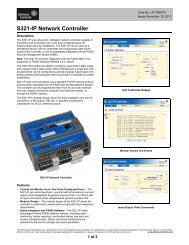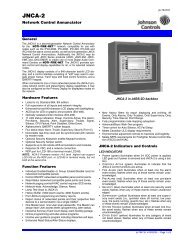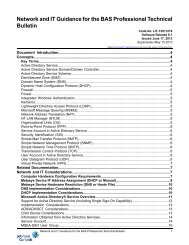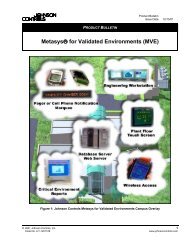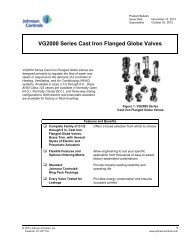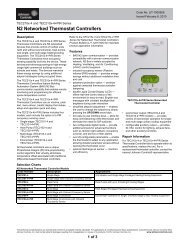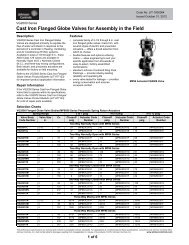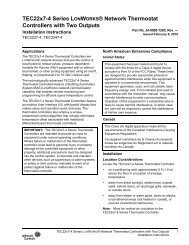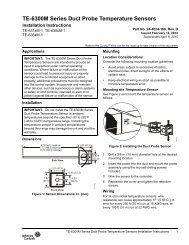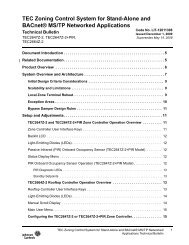YVAA Style A Air-Cooled Screw Liquid Chillers ... - Johnson Controls
YVAA Style A Air-Cooled Screw Liquid Chillers ... - Johnson Controls
YVAA Style A Air-Cooled Screw Liquid Chillers ... - Johnson Controls
You also want an ePaper? Increase the reach of your titles
YUMPU automatically turns print PDFs into web optimized ePapers that Google loves.
FORM 201.28-NM1.1<br />
ISSUE DATE: 8/29/2012<br />
DELIVERY AND STORAGE<br />
SECTION 3 - HANDLING AND STORAGE<br />
To ensure consistent quality and maximum reliability,<br />
all units are tested and inspected before leaving the factory.<br />
Units are shipped completely assembled and containing<br />
refrigerant under pressure. Units are shipped<br />
without export crating unless crating has been specified<br />
on the Sales Order.<br />
If the unit is to be put into storage, prior to installation,<br />
the following precautions should be observed:<br />
• The chiller must be “blocked” so that the base is<br />
not permitted to sag or bow.<br />
• Ensure that all openings, such as water connections,<br />
are securely capped.<br />
• Do not store where exposed to ambient air temperatures<br />
exceeding 43°C (110°F).<br />
• The condensers should be covered to protect the<br />
coils and fins from potential damage and corrosion,<br />
particularly where building work is in progress.<br />
• The unit should be stored in a location where there<br />
is minimal activity in order to limit the risk of accidental<br />
physical damage.<br />
• To prevent inadvertent operation of the pressure<br />
relief devices the unit must not be steam cleaned.<br />
• It is recommended that the unit is periodically inspected<br />
during storage.<br />
INSPECTION<br />
Remove any transit packing and inspect the unit to ensure<br />
that all components have been delivered and that<br />
no damage has occurred during transit. If any damage<br />
is evident, it should be noted on the carrier’s freight bill<br />
and a claim entered in accordance with the instructions<br />
given on the advice note.<br />
Major damage must be reported immediately to your<br />
local <strong>Johnson</strong> <strong>Controls</strong> representative.<br />
MOVING THE CHILLER<br />
Prior to moving the unit, ensure that the installation<br />
site is suitable for installing the unit and is easily capable<br />
of supporting the weight of the unit and all associated<br />
services.<br />
The units are designed to be lifted using shackles or<br />
safety hooks. A spreader bar or frame should be used<br />
in order to prevent damage to the unit from the lifting<br />
chains. (Refer to Figure 4 on Page 20 for hooks.)<br />
Units are provided with lifting eyes in the sides of the<br />
base frame, which can be attached directly using container<br />
lugs, shackles or safety hooks (see Figure 4 on<br />
Page 20 for proper lifting illustration).<br />
The unit must only be lifted by the base<br />
frame at the points provided. Never move<br />
the unit on rollers, or lift the unit using a<br />
forklift truck.<br />
Care should be taken to avoid damaging the condenser<br />
cooling fins when moving the unit.<br />
LIFTING WEIGHTS<br />
For details of weights and weight distribution, refer to<br />
the data shipped in the chiller information packet and<br />
unit nameplate.<br />
JOHNSON CONTROLS 19<br />
3



